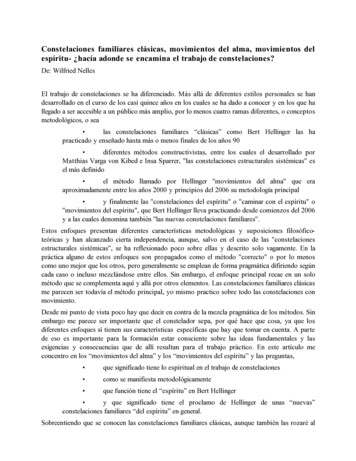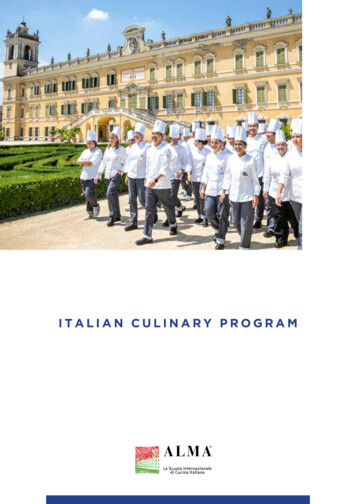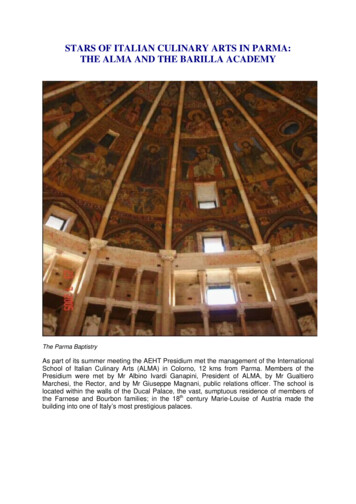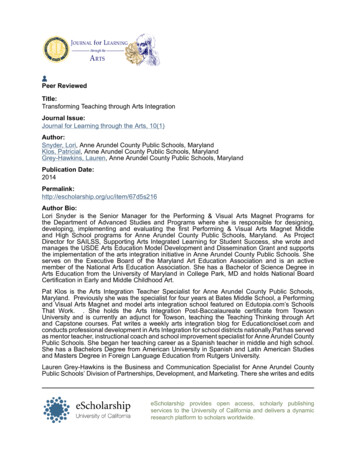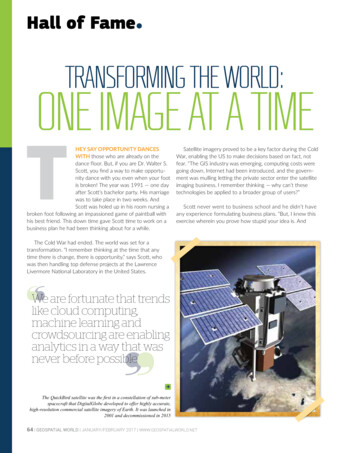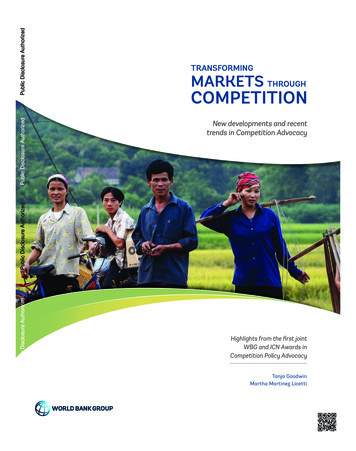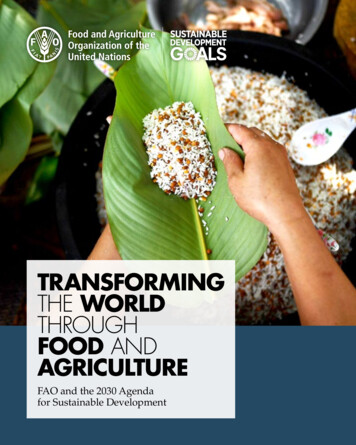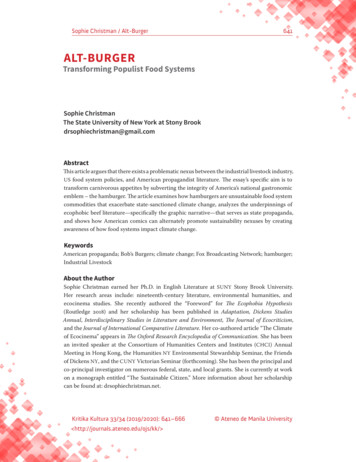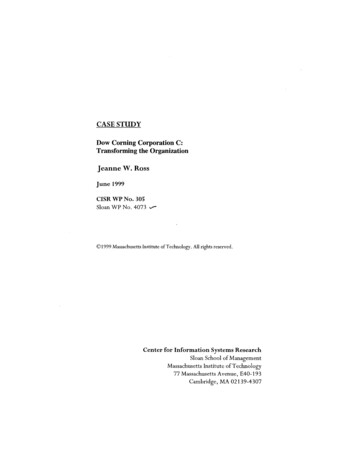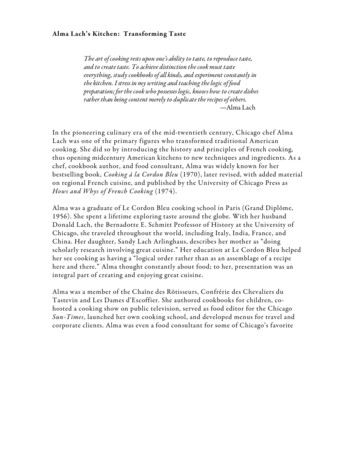
Transcription
Alma Lach’s Kitchen: Transforming TasteThe art of cooking rests upon one’s ability to taste, to reproduce taste,and to create taste. To achieve distinction the cook must tasteeverything, study cookbooks of all kinds, and experiment constantly inthe kitchen. I stress in my writing and teaching the logic of foodpreparation; for the cook who possesses logic, knows how to create dishesrather than being content merely to duplicate the recipes of others.—Alma LachIn the pioneering culinary era of the mid-twentieth century, Chicago chef AlmaLach was one of the primary figures who transformed traditional Americancooking. She did so by introducing the history and principles of French cooking,thus opening midcentury American kitchens to new techniques and ingredients. As achef, cookbook author, and food consultant, Alma was widely known for herbestselling book, Cooking à la Cordon Bleu (1970), later revised, with added materialon regional French cuisine, and published by the University of Chicago Press asHows and Whys of French Cooking (1974).Alma was a graduate of Le Cordon Bleu cooking school in Paris (Grand Diplôme,1956). She spent a lifetime exploring taste around the globe. With her husbandDonald Lach, the Bernadotte E. Schmitt Professor of History at the University ofChicago, she traveled throughout the world, including Italy, India, France, andChina. Her daughter, Sandy Lach Arlinghaus, describes her mother as “doingscholarly research involving great cuisine.” Her education at Le Cordon Bleu helpedher see cooking as having a “logical order rather than as an assemblage of a recipehere and there.” Alma thought constantly about food; to her, presentation was anintegral part of creating and enjoying great cuisine.Alma was a member of the Chaîne des Rôtisseurs, Confrérie des Chevaliers duTastevin and Les Dames d’Escoffier. She authored cookbooks for children, cohosted a cooking show on public television, served as food editor for the ChicagoSun-Times, launched her own cooking school, and developed menus for travel andcorporate clients. Alma was even a food consultant for some of Chicago’s favorite
local restaurants, The Pump Room and The Berghoff. In addition, Alma invented aningenious kitchen tool, the Curly Dog Cutting Board. There was nothing she couldnot do.Visitors to the exhibition will enjoy material from the Alma Lach Papers, as well asfrom her extensive cookbook collection. Alma collected more than 3,000 cookbooksreflecting her broad range of interests in food preparation and dining, from classicFrench and Chinese cuisine, to cookbooks popularizing the foods of Americanethnic groups, and recipe books produced by churches and volunteer groups.Enjoy yourselves as you enter Alma’s culinary world!The exhibition Alma Lach’s Kitchen: Transforming Taste was curated by Eileen Ielmini, BrittanNannenga, and Catherine Uecker along with exhibition designer, Joseph Scott. In addition toselections from the Alma S. Lach Papers and the Alma Lach Culinary Library, the exhibitionalso includes a few selections from the University of Chicago Press Records.The Special Collections Research Center is indebted to Sandra Lach Arlinghaus and WilliamC. Arlinghaus for donating Alma’s papers and cookbook collection to the Library. We are alsograteful to Sandy for all her support and guidance as we developed the exhibition. Hermemories of her mother were invaluable.Author and EducatorEarly in her career, Alma Lach published a cookbook for children, A Child’s FirstCook Book (1950), with picture recipes and simple instructions for making snacksand party foods. She went on to publish three additional cookbooks for children:The Campbell Kids Have a Party (1954), The Campbell Kids at Home (1954), andLet’s Cook (1956).The success of Alma’s children’s cookbooks encouraged her to try writing acookbook for men. The unpublished manuscript for this cookbook includesrecipes for meat, salads, and vegetables, which she found to be “appealing tomen and at the same time not too exacting.”
In 1970 Alma published Cooking à la Cordon Bleu. When the Parisian schoolprotested about the use of its name without permission, Harper & Row declined toreissue the book under another title. The rights to the cookbook reverted to Almaand she subsequently republished it, with expanded sections on regional Frenchcuisine, with the University of Chicago Press in 1974 as Hows and Whys of FrenchCooking. It was an immediate success.During this time, she also launched a subscription cooking publication, Alma’sAlmanac. Beginning with the first issue in 1972, the Almanac provided seasonalmenu plans, recipes, and other culinary hints to its monthly subscribers. In additionto her published books, Alma wrote twice-weekly columns as food editor of theChicago Sun-Times, as well as a number of magazine articles, booklets, andbrochures over the course of several decades. She also spent many years traveling,developing, and testing recipes for a book on Chinese cooking that she was neverable to complete.Le Cordon BleuAlma was one of the first Americans to receive the Grand Diplôme from Le CordonBleu cooking school in Paris, France. Her husband, Donald, a history professor atthe University of Chicago, won a Fulbright Scholarship to study in France in 1949,and they lived together in Paris with their daughter, Sandy, for three one-yearperiods between then and 1956. At Donald’s suggestion Alma decided to enroll at LeCordon Bleu to occupy her time and, as Donald declared, “.learn to make a sauce.I’m tired of country gravy.”Alma attended Le Cordon Bleu cooking classes during the day, and in the eveningsshe duplicated the dishes she had made in class at home for Donald and Sandy. If adish tasted slightly ‘off’ to her sensitive palate, she worked tirelessly to improve it.She filled several spiral-bound notebooks with French recipes and masteredhundreds of different sauces before earning her diploma in 1956.Honors and Accolades
Alma Lach received many distinctive awards and honors throughout her culinarycareer. Early on, as a consequence of earning the Grand Diplôme from Le CordonBleu cooking school, she was granted membership in the Légion d’Honneur by theFrench government and awarded a blue lapel ribbon with accompanying rosettes.Alma wore these while living in France and could reportedly get a table in a crowdedrestaurant as a result. Back home in Chicago in 1958, she was awarded a mink stolefor first prize in the Pillsbury Creative Recipe Content for Newspaper and MagazineFood Editors for her work as food editor at the Chicago Sun-Times. Alma was alsoone of the first American women to be inducted as a full member of the Confrériedes Chevaliers du Tastevin in 1962, an association devoted to promoting the winesand cuisine of Burgundy. In 1964 she became a member of the Chaîne desRôtisseurs, the world’s oldest international gastronomic society, founded in Paris in1248.BusinesswomanAlma Lach’s training at Le Cordon Bleu cooking school was the foundation for hercommitment to expanding and perfecting her culinary skills and teaching others,which she accomplished through numerous business endeavors. She became foodeditor of the Chicago Sun-Times in 1957, where she wrote Sunday and Thursdaycolumns on gourmet cookery, experimented with recipes in her test kitchen, andlearned the art of food photography.After leaving the Chicago Sun-Times in 1965, she launched the Alma Lach CookingSchool. She started out leading classes on French cuisine, teaching her students thepreparation and service of full French dinners and allowing them to develop theirown “creative talents in the adventure of fine food.” She eventually expanded thecurriculum to include classes on Chinese cuisine and the foods of Japan and India.Alma made many local and national television appearances over the years to inspire awide range of audiences. She created, produced, and starred in her own children’scooking series, Let’s Cook (1955),first broadcast on WTTW and then on WGN-TV.She appeared weekly as nutritionist and cooking expert, preparing gourmet dishesfor people of retirement age, on the PBS television series, Over Easy (1977-78), withHugh Downs. She also did cooking demonstrations on the Lee Phillip Show onWBBM-TV and was a guest on many of the Today shows across the country.
As president of Alma Lach Kitchens, Inc., Alma tested recipes and products, createdmenus, and offered guidance on all aspects of food and dining. She was a consultantto Chicago restaurants The Pump Room, working with Rich Melman of LettuceEntertain You, and The Berghoff, and she designed gourmet airline meals for FlyingFood Fare that debuted on Midway Airlines flights from Chicago to New York.Inventor: From Haute Cuisine to the Dogs!Through the vehicle of her business Alma Lach, Inc., Alma developed an ingeniouskitchen tool that brought delight to many adults and children. In a letter to a friendin the 1990s Alma wrote, “I’ve gone from ‘Haute Cuisine’ to the Dogs!” She wasspeaking of her invention, the Curly Dog Cutting Board. The multi-purpose cuttingboard was patented in 1995, and was sold through department stores, kitchencatalogs, and friends. Alma even sent a Curly Dog Cutting Board to the DavidLetterman Show. Alma also developed additional products that she marketed underthe Alma Lach, Inc. name, including a type of soured cream and Steak Char, whichwas a seasoning that tasted as if your food had been cooked on a grill. Steak Charwas originally developed while Alma was the food consultant at The Pump Room,for Rich Melman.Although not on display, one of Alma’s last inventions was known as the WalkerTray. After an accident involving an attempt to hang a piece of her floral artwork,Alma ended up with a broken leg that required the use of a walker until sherecovered. Having never needed assistance before, Alma became thoroughlyfrustrated with the inability to carry one’s dinner and drink easily to the table. Onceagain the lightbulb went off, a design was created, and the Walker Tray wasmarketed. As her daughter Sandy has pointed out, this invention was created at thetender age of 90.Culinary TravelerAlma married University of Chicago History Professor Donald Lach in 1939. Thetwo had a life filled with travel, exploration, and wonderful cuisine. Donald wasawarded a Fulbright to do scholarly research in France from 1949-1950, a Social
Science Research grant from 1952-1953, and additional funding to work in Asiaand Europe in 1955-1956. Alma’s travels with Donald to Paris and throughoutEurope started for her what was to be a lifetime of culinary pursuits. Their travelstogether to Europe, China, India, and Japan expanded Alma’s interests in thecreation and preparation of regional cuisines.Alma’s own expertise, having graduated from Le Cordon Bleu cooking school, allowedher to examine regional cuisine with a careful eye. While traveling through IndiaAlma became interested in how cinnamon was grown, harvested and used. Alma wrotean article she entitled “Stalking the Cinnamon Stick.” Alma took these amazingphotographs of the local families working with the cinnamon.Following another culinary trail, Alma pursued the elusive truffle. Hoping to write afeature article, Alma reached out to the world-renowned Urbani family. CarloUrbani had taken the family’s 19th century business and transformed it into a globalentity. Alma and Donald visited Italy where they met with Carlo and Paolo Urbaniand the truffle hunters and their dogs. Alma learned the art of the hunt and whatwas needed to forage for truffles. Paolo showed her aspects of the business itself, asAlma participated with the staff as they cleaned and packaged truffles that would beshipped around the world.Another highlight from Alma’s travels was a trip she took to China with Donald inthe early 1980s. Alma learned the famous Paris restaurant, Maxim’s de Paris, wasopening a subsidiary in Beijing. She reached out to the Chicago Sun-Times andpitched the idea of writing an article about the new restaurant. Her subsequentcritique of the restaurant and its menu did not hold back. Alma clearly respectedChef Jean-Louis Bruneau. She noted the growing pains of a new restaurant; Maxim’sBeijing had only recently opened when she visited. Her article highlighted asignature dessert with emphasis on accommodations for the American householdchef.In Alma’s KitchenThe kitchen is a crucial element to the work of any good culinary explorer. Whetherduring the days when Alma Lach was studying at Le Cordon Bleu cooking school,writing her various cookbooks, or consulting for restaurants and corporate clients,
she was in her kitchen experimenting and refining. Alma generally did not cookfrom recipes, she wrote them. Alma’s daughter Sandy recollects “she thought aboutfood all the time. She read cookbooks as one reads sources in advance of writing.”Alma could tell if a recipe would work or not. “One had to be able to taste what onewas reading, rather than just blindly following a recipe.”Alma loved appetizers, elaborate cocktail party food, and fantastic main dishes. Eachmeal was an adventure. A favorite was always Pâté de Foie Gras in a rooster mold,decorated elaborately with carved vegetables and a coating of brushed butter thatsimulated feathers. Alma’s attention to detail also extended to the illustrations ofkitchen tools and equipment she used for her book, Hows and Whys of FrenchCooking; these line drawings were based on items in her own kitchen.Alma worked in numerous kitchens throughout her lifetime. Her own kitchen wasan amazing space with her cookbook collection and culinary notebooks close athand. She had an array of copper pots, which she began collecting shortly aftergraduating from Le Cordon Bleu, all pristinely maintained. Some of her culinarycreations also utilized particular terrines and dishes. Featured in the exhibition is afavorite terrine with pheasant lid. Alma’s kitchen also served as an official licensedtest kitchen, first in their apartment at 5759 Kenwood Avenue, then at 5750Kenwood Avenue. When Alma launched her cooking school in 1967, she usedkitchens in the Gas Company Auditorium on South Michigan Avenue and later inthe International Institute of Foods and Family Living on North Rush Street.Alma Lach’s Culinary LibraryAlma Lach amassed a collection of cookbooks during the course of her culinarycareer that numbered well over 3,000 volumes. The collection ranged from classicAmerican works like Betty Crocker’s Picture Cook Book (1950) and Better Homes andGardens Cookbook (1941) to volumes on exotic cuisines such as Russian, Indonesian,Finnish, and Tibetan. The oldest volumes in the collection include ones onceowned by her mother, Clara Satorius. They include many handwritten notes,something that Alma also did in her own cookbooks. From these early works, Almabuilt her culinary collection as a scholar builds a research library.Of particular interest to Alma were cookbooks produced by church groups. Thereare well over 100 of them in her collection. Alma was as interested in this genre as
she was in the best-selling, classic cookbooks because she felt that the recipes inthem were tried and true and therefore could be trusted.Following the success of her Hows and Whys of French Cooking, Alma began researchfor a cookbook she tentatively titled The Two Great Cuisines – French and Chinese.Her collection reflects her extensive work in these areas with hundreds of cookbookson these two cuisines, in a variety of languages, many heavily annotated by her withnotes and changes as she tested recipes.
Alma Lach’s training at Le Cordon Bleu cooking school was the foundation for her commitment to expanding and perfecting her culinary skills and teaching others, wh
